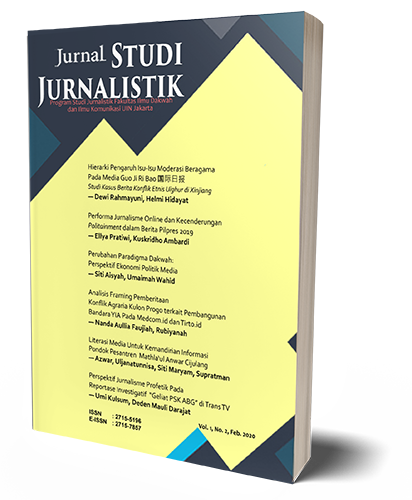Media Sosial Sebagai Sumber Berita Altenatif
DOI:
https://doi.org/10.15408/jsj.v4i2.28966Keywords:
Journalism social media, social media news, anline portal social mediaAbstract
Journalism is currently growing and developing with digital media. Digitization of journalism has penetrated into social media. Social media platforms on news can be used as news providers. Tiktok, Twitter, Facebook and Instagram are social media used in digital news. This study aims to determine the extent to which the role of social media Tiktok, Twitter, Facebook and Instagram is more accepted than conventional media in the news portals Kompas.com, Tempo.co and Republika.co.id. The online portals that are the object of research are Kompas.com, Tempo.co and Republika.co.id. This study uses a qualitative knife to dissect. The data collection technique in this study was the researcher observing the social media accounts of Kompas.com, Tempo.co and Republika.co.id. Furthermore, the researchers dig up information by interviewing the editors of Kompas.com, Tempo.co and Republika.co.id. The findings in this study conclude that Tiktok, Twitter, Facebook and Instagram are more accepted than conventional print media. The comment column is the most favorite thing for readers of the Kompas.com, Tempo.co and Republika.co.id portals on their respective social media. By using social media, it has the impact that the news is getting closer to the community, not at the exclusive level, but the news can be enjoyed egalitarianly.References
Arifin, P. (2013). PERSAINGAN TUJUH PORTAL BERITA ONLINE INDONESIA BERDASARKAN ANALISIS USES AND GRATIFICATIONS.JURNAL ILMU KOMUNIKASI,10(2). https://doi.org/10.24002/JIK.V1 0I2.353
Allgaier, J., Dunwoody, S., Brossard, & Peters, H. P.(2013). JOURNALISM AND SOCIAL MEDIA AS MEANS OF OBSERVING THE CONTEXTS OF SCIENCE. BIOSCIENCE, 63(4),284–287. https://doi.org/10.1525/BIO.201 3.63.4.8
Dewan Pers. (2020). ETIKA MENJAGA DAN MELINDUNGIKEMERDEKAAN PERS. BERITA DEWAN PERS, 11(November), 1–12.
Deuze, M. (2008). THE CHANGING NATURE AND CONTEXT OF SOCIAL WORK RESEARCH. INTERNATIONAL JOURNAL OF COMMUNICATION, 2,848–865. https://doi.org/10.1093/bjsw/31. 5.687
Edgerly, S., & Vraga, E. K. (2019). NEWS, ENTERTAINMENT, OR BOTH? EXPLORING AUDIENCE PERCEPTIONS OF MEDIA GENRE IN A HYBRID MEDIA ENVIRONMENT. JOURNALISM, 20(6),807–826. https://doi.org/10.1177/1464884 917730709
Foust, J. S. (2011). ONLINE JOURNALISM: PRINCIPLES AND PRACTICES OF NEWS FOR THE WEB (3rd ed.). Routledge. https://journals.sagepub.com/doi/ abs/10.1080/1931243080241822 0
Nuraeni, R. (2017). PERAN MEDIA SOSIALDALAM TUGAS JURNALISTIK. JURNAL ILMIAH LISKI (LINGKAR STUDI OMUNIKASI), 3(1), 43–58. https://doi.org/10.25124/LISKI. V3I1.806
Mersey, R. D., Malthouse, E. C., & Calder, B. J. (2010). ENGAGEMENT WITH ONLINE MEDIA. JOURNAL OF MEDIA BUSINESS STUDIES, 7(2), 39–56. https://doi.org/10.1080/1652235 4.2010.11073506
Romli, A. S. (2018). JURNALISTIK ONLINE: PANDUAN MENGELOLA MEDIA ONLINE (3rd ed.). Penerbit Nuansa Cendekia.
Setiawan, A. (2020). MEDIA ONLINE PERLUBERBENAH.Medcom.Id. https://www.medcom.id/pilar/kol om/Wb70Wyak-media-online- perlu-berbenah- diri?utm_source=apps_android& utm_medium=share&utm_camp aign=share
Syamsul, A., & Romli, M. (n.d.). JURNALISTIK ONLINE: JURNALISTIK MASA DEPAN. Retrieved September 14, 2021, from www.romelteamedia.com
Quesenberry, K. (2019). SOCIAL MEDIA STRATEGY : MARKETING, ADVERTISING, AND PUBLIC RELATIONS IN THE CONSUMER REVOLUTION.
Tandoc, C., & Jenkins, J. (2017). THE BUZZFEEDICATION OF JOURNALISM? HOW TRADITIONAL NEWS ORGANIZATIONS ARE TALKING ABOUT A NEW ENTRANT TO THE JOURNALISTIC FIELD WILL SURPRISE YOU! JOURNALISM, 18(4), 482–500. https://doi.org/10.1177/1464884 915620269
Tandoc, E. C. (2018). FIVE WAYS BUZZFEED IS PRESERVING (OR TRANSFORMING) THE JOURNALISTIC FIELD. JOURNALISM, 19(2), 200–216. https://doi.org/10.1177/1464884 917691785
Weaver, D., & Willnat, L. (2016). CHANGESINU.S.JOURNALISM: HOW DO JOURNALISTS THINK ABOUT SOCIAL MEDIA?JOURNALISM PRACTICE,10(7), 844–855. https://doi.org/10.1080/1751278 6.2016.1171162















